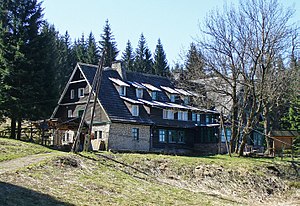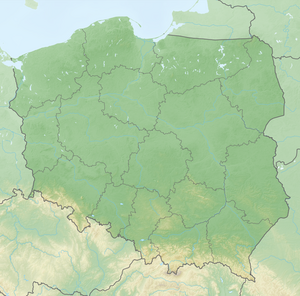Baude Pod Muflonem
| Baude Pod Muflonem (Polish: Schronisko "Pod Muflonem"; German until 1945: Baude "Stille Liebe") PTTK hut |
||
|---|---|---|
|
The hut in April 2007 |
||
| location | On the northeast slope of Ptasia Góra; Poland | |
| Mountain range | Habelschwerdter Mountains , Sudeten | |
| Geographical location: | 50 ° 23 '29 .1 " N , 16 ° 23' 52.1" E | |
| Altitude | 690 m npm | |
|
|
||
| owner | PTTK | |
| Built | rebuilt in 1964 | |
| Construction type | Hut; Stone, wood | |
| Usual opening times | open all year | |
| accommodation | 50 beds, - | |
| Web link | Site of the hut | |
The Baude Pod Muflonem ( Polish Schronisko PTTK "Pod Muflonem" , German until 1945: Silent Love ) is a mountain hut above Bad Reinerz ( Polish Duszniki-Zdrój ), a spa town in the powiat Kłodzki in the Lower Silesian Voivodeship in Poland.
Location and description
The hut is located at an altitude of 690 m npm on the northeast slope of Ptasia Góra, ( Vogelberg , 745 m), about 1.5 kilometers from the city center of Duszniki-Zdrój and about 160 meters higher. The Ptasia Góra belongs to the Habelschwerdter Mountains , a mountain range of the Sudetes . The hut can be reached via several hiking trails.
The one-story building on a rectangular floor plan has a facade made of natural stone and wood. The gable roof is clapboard and extended over two floors, with windows in sheet metal dormer windows . This is where the 50 beds available for overnight stay are preferably accommodated. The roof ridge runs in a cross shape so that four gable sides are created. In the guest room hang mouflon heads , which gave the building its name.
In front of the building there is a protected ash tree named Bolko , which was planted in 1866, and a younger one next to it. An observation platform offers a view of Bad Reinerz and the Heuscheuer Mountains ( Góry Stołowe ).
history
The history of the hut is linked to the development of the spa business in Bad Reinerz. In the second half of the 19th century, more emphasis was placed on the effects of milk. In the place of today's hut there was a farm that served milk to walkers from the village. When milk treatment was given up around the turn of the century, the house developed into an inn that also offered overnight accommodation. Already at the time of the farm the name "Silent Love" had become common. In winter, a curvy toboggan run leading into the spa district, which was used until the 1960s, was a special attraction.
During the Second World War , the hut served as a rest home for the supervisory staff of the Auschwitz concentration camp . After the transition to Poland in 1945, the German population was expelled in 1946. With the change in the social order, the nature of tourism also changed. State organizations took over the building, first the state hotel company Orbis and then the Polish Tourism and Regional Studies Association PTTK , with the building being named "Pod Muflonem".
In October 1959 a fire destroyed the building. Reconstruction began soon, and in 1964 the new building, similar to the old one but significantly larger, was able to resume operations.
literature
- Marek Staffa (ed.): Słownik geografii turystycznej Sudetów. Vol. 14: Góry Bystrzyckie i Orlickie . Warszawa-Kraków: Wydawnictwo PTTK “Kraj”, 1992, ISBN 83-7005-340-8 , pp. 174-176.
- Aloys Bernatzky : Lexicon of the county Glatz. Marx Verlag Leimen / Heidelberg 1984, ISBN 3-931019-06-3 , p. 23.
Web links
- Historia (Polish). Accessed May 31, 2018 .
- Site of the cottage. Accessed May 31, 2018 .
- History as well as historical and current recordings ( Polish )
Individual evidence
- ^ Karl Baedeker: Silesia . Leipzig 1938, p. 189, map




